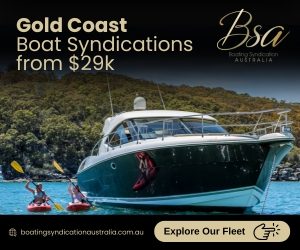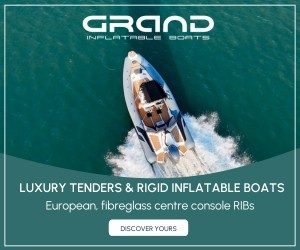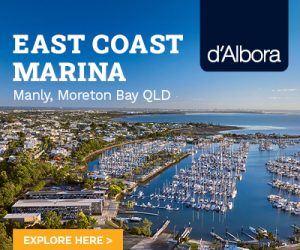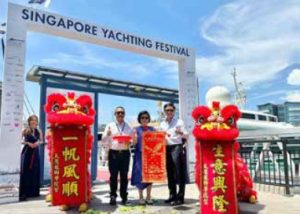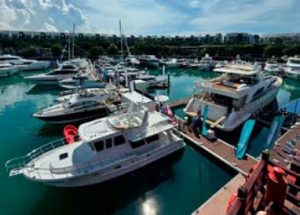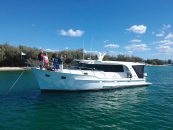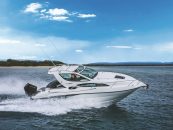By Roselle Tenefrancia
A CONFERENCE,
A BOAT SHOW,
A WOODEN SAILING SHIP
Singapore has always been an Asian hub for international commerce and travel. It is a familiar stop for people from the Oceania region, such as Australia and New Zealand, when traveling to Asia, Europe and beyond. It is also a food haven with hawker centres, food courts and international restaurants at every corner of the city. While it is also known for its expertise in land reclamation developments, such as Sentosa Island, it is not well known as a recreational boating hub. So it was out of our curiosity (and our need to reconnect with Asia) that we decided to visit their annual marine event, the Singapore Yachting Festival (SYF), which also hosted the inaugural ICOMIA (International Council of Marine Industry Associations) Boating Industry Conference 2024 in April held in Sentosa Cove Singapore.
The conference showcased the work of ICOMIA to connect the recreational boating industry in Asia. With the key themes of sustainable business practices for long-term growth and guidance for decarbonisation in the recreational marine industry, the presenters and panelists from Asia provided overviews of their initiatives and programs that promote these key themes. Like most boating enthusiasts, the businesses affirm the need to use new technologies to ensure that boating remains an enjoyable experience without contributing to carbon emissions. While decarbonisation is the vision, harnessing the strengths of all available technologies is something that proves to be most effective in providing the desired power and at the same time ensuring environmental sustainability.
There is a consensus that sustainability should be multifaceted and pragmatic, incorporating not only environmental and social factors but also financial and economic considerations.
Interestingly, the World Wild Fund for Nature (WWF) presentation showed that many countries in Southeast Asia are part of the coral triangle, which also includes Papua New Guinea and northern parts of Australia. The coral triangle is the global epicentre of marine biodiversity, and is under threat from increasing pressures that include unsustainable fishing practices, land-based sources of marine pollution, coastal habitat conversion and climate change (source: CTI). The boating sector has a role to play in addressing these threats. Indeed, as affirmed by many of the presenters, the love for boating will definitely be enhanced if we are also able to protect and preserve the environment in which we enjoy this activity.
In Asia, recreational boating remains an “elitist” activity; it is perceived as only for the super rich. Even while Southeast Asian countries have extensive coastlines and abound with waterways, seafaring life is still culturally embedded in fishing, tourism, transport and cargo. One of the challenges for the recreational boating sector then is to create a bridge between traditional seafaring and contemporary leisure boating experiences. There is obviously a need for the global boating sector to conduct more research on the cultural barriers that impact the growth of recreational boating in the region.
One way of educating the local people on the lifestyle is holding events that are easily accessible to the general public. This is where the Singapore Yachting Festival may play a significant role. Held at ONE°15 Marina Sentosa Cove in April, the SYF 2024 boasted an impressive showcase of the yachting industry. The SYF highlighted Singapore’s emergence as a prominent yachting hub, boasting expertise, accessibility, and top-notch infrastructure capable of hosting unique on-water exhibitions.
The vessels on display ranged from alternative fuel solutions and electric hydro-foiling craft. We were able to enjoy hands-on experiences in the clean waters of the marina with Seabob. We also had an adventure ride with RHIB Rides Singapore to see some of the islands on the Singapore Strait, providing a glimpse of what Singapore islands have to offer to the boater.
The boat show was held in Sentosa Cove, an integrated residential-marina resort development on the eastern coast of Sentosa Island, to the south of mainland Singapore. It is largely a residential estate, featuring Singapore’s first gated residential community. The land that Sentosa Cove sits on consists partly of reclaimed land and partly of what used to be an isle called Buran Darat, that was situated east of Sentosa. The marina at One°15 has 272 wet berths including 32 for mega-yachts, making it the first in Singapore that can accommodate large vessels at least 85 ft long.
Of special interest was the unique exhibit of the Fu Ning, the world’s largest sea-going traditional Chinese wooden sailing boat, built as part of a commitment to UNESCO by Ningde City, Fuijan Province to preserve the “Fuzhou watertight compartment manufacturing technology” and promote traditional Chinese maritime culture. Utilising high-quality materials like rosewood for its construction, the vessel has remarkable stability, wind resistance, and ocean-going capabilities. A symbol of the enduring cultural exchange along the maritime silk road, Fu Ning aims to retrace Admiral Cheng Ho’s historic voyages, honouring his legacy, promoting traditional Chinese maritime culture, and facilitating cultural exchange with countries along its journey.
Photos by Singapore Yacht Festival and Andy Kancachian
Admiral Cheng Ho was selected by the emperor to be commander in chief of what became a series of missions to the “Western Oceans.” He first set sail in 1405 to Southeast Asia and the coasts of India and Sri Lanka. His other voyages brought his fleet to the coasts of Arabia and Egypt, the east coast of Africa, the Persian Gulf, and the Red Sea. While these expeditions did not lead to the establishment of trading empires, in their wake, Chinese emigration increased, resulting in Chinese colonisation in Southeast Asia and the accompanying tributary trade, which lasted until the 19th century.
While the SYF primarily showcased the modern-day recreational vessels, the presence of a traditional merchant ship gave a sense of place, and a glimpse at the maritime history in the region. It was a reminder of the Chinese maritime presence in Southeast Asia and how it has influenced the shaping of the culture and traditions of peoples in the region through their exceptional seafaring technology and skills.
Overall, our experiences in Singapore were exciting and relatively new. While Sentosa Cove has similar amenities and infrastructure as our local integrated developments, and the Singapore Yachting Festival akin to a smaller scale SCIBS, the Asian (Singaporean) touch is still manifest and the warm climate very palpable.
Published in print August-December 2024


